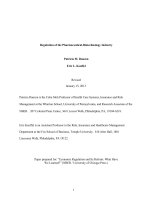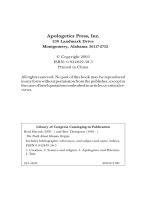Expansion of the Vietnamese Handicraft Industry From Local to Global
Bạn đang xem bản rút gọn của tài liệu. Xem và tải ngay bản đầy đủ của tài liệu tại đây (1.12 MB, 101 trang )
EXPANSION OF THE VIETNAMESE HANDICRAFT INDUSTRY:
FROM LOCAL TO GLOBAL
A thesis presented to
the faculty of
the Center for International Studies of Ohio University
In partial fulfillment
of the requirements for the degree
Master of Arts
Rachael A. Szydlowski
August 2008
2
This thesis titled
EXPANSION OF THE VIETNAMESE HANDICRAFT INDUSTRY:
FROM LOCAL TO GLOBAL
by
RACHAEL A. SZYDLOWSKI
has been approved for
the Center for International Studies by
Yeong-Hyun Kim
Associate Professor of Geography
______________________________________________
Gene Ammarell
Director, Center for Southeast Asian Studies
Drew McDaniel
Interim Director, Center for International Studies
3
Abstract
SZYDLOWSKI, RACHAEL A., M.A., August 2008, Southeast Asian Studies
EXPANSION OF THE VIETNAMESE HANDICRAFT INDUSTRY: FROM
LOCAL TO GLOBAL
(101 pp.)
Director of Thesis: Yeong-Hyun Kim
Handicrafts have become increasingly popular in the global market. Countries throughout
the developing world are exporting handicrafts to the developed world, creating a new
source of revenue and employment. The recent development of the Vietnamese
handicraft industry and the role that government policies and exporting businesses play in
it are the focus of this thesis. Handicraft villages and artisans serve as the producers of
handicrafts, while handicraft exporting businesses find and provide the artisans with
marketing opportunities for their products. This thesis draws upon in-depth interviews
with two handicraft villages, Dong Ho and Ngoc Dong villages, as well as three
exporting businesses, Craft Link, Ngoc Dong Weaving Company, and Hoa Lu Fine Arts
and Handicrafts.
Approved:
Yeong-Hyun Kim
Associate Professor of Geography
4
Acknowledgments
I would like to express deep appreciation to Dr. Yeong-Hyun Kim, my advisor for
this project, for her many hours of guidance, encouragement, advice, and sense of humor
throughout the duration of this project. I would also like to thank Dr. Drew McDaniel and
Dr. Gregory Emery for their suggestions and advice in doing my research and writing this
paper. I am appreciative of the Luce grant I received from the Center for Southeast Asian
Studies, which allowed me to travel to Vietnam to conduct my research interviews.
I would also like to thank my friends for their support during my research. A
special thanks to Dang Thu, my Vietnamese tutor and friend, who tailored my language
study towards my travels to Vietnam, and who connected me with friends while in
Vietnam. I would also like to thank Phan Cuong and Tang Thi Phuong Mai, who each
supported me and provided advice throughout my time in Hanoi and Karl Federspiel and
Karla Schneider, for reading and providing me with insight on my thesis.
Finally, I want to thank my family for all the support they have provided during
my time at Ohio University.
5
Table of Contents
Abstract 3
Acknowledgements 4
List of Tables 7
List of Figures 8
List of Maps 9
List of Photos 10
Chapter 1- Introduction 11
1.1 – Research Area 13
1.2 – Research Methods 16
Chapter 2-
Rural Development and Handicraft Industries in Low-Income Countries 19
2.1- Rural Industrialization 19
2.2- Rural Industrialization in Transition Economies 27
2.3- Rural Development and Handicraft Industries 30
Chapter 3- The Vietnamese Economy in Transition 33
3.1- A Brief History of Vietnam Prior to Doi Moi 33
3.2- Vietnam in the Age of Doi Moi and Beyond 35
3.3- Government Policies on Rural Industrialization 45
Chapter 4- Handicraft Industries in Vietnam 50
4.1-Handicraft Villages 52
4.2- Government Involvement in Handicraft Industries 54
4.3- Export of Handicrafts 57
Chapter 5- Handicraft Villages in the Red River Delta 60
5.1- Dong Ho Village 61
5.2- Ngoc Dong Village 66
5.3- Causes of Village Growth 70
Chapter 6- Marketing Networks in Handicraft Industries 72
6.1- Craft Link 72
6.2- Ngoc Dong Weaving Company 77
6.3- Hoa Lu Fine Art and Handicrafts Company 82
6
Chapter 7- Conclusion 88
Bibliography 93
Appendix A 99
Appendix B 100
Appendix C 101
7
List of Tables
Table 6.1- Comparing the Export Industries 86
8
List of Figures
Figure 3.1-Vietnam’s Gross National Income Per Capita: 1984-2004 38
Figure 3.2: Vietnam’s Economic Structure: 1990-2003 39
Figure 3.3- Vietnam’s Economic Structure: 1985-2004 40
Figure 3.4: Trade Structure of Vietnam: 1996-2002 41
Figure 3.5: Foreign Direct Investment in Vietnam 44
Figure 4.1- Major Players in the Vietnamese Handicraft Industry 50
Figure 4.2- Handicraft Exports in Vietnam 58
Figure 6.1- Breakdown of Craft Link’s business practices 75
Figure 6.2- Breakdown of Ngoc Dong’s business practices 80
Figure 6.3- Breakdown of Hoa Lu’s business practices 84
9
List of Maps
Map 1.1: Map of Vietnam 14
Map 1.2: Regions and Provinces of Vietnam 15
10
List of Photos
Photo 5.1: Dong Ho painting with traditional image 62
Photo 5.2: Dong Ho paintings being produced in home 63
Photo 5.3: New product line by Dong Ho artisan 64
Photo 5.4: Daughter of artisan demonstrates how the paper is made for the Dong Ho
paintings 65
Photo 5.5: A small handicraft industry in Ngoc Dong, specializing in rattan furniture 68
Photo 5.6: Master artisan (right) and craftworker (left) in Ngoc Dong village 69
Photo 6.1- Craft Link’s store in Hanoi 73
Photo 6.2- Artisans such as these benefit from the help of Craft Link 76
Photo 6.3- Ngoc Dong works with large companies, such as Marshalls 78
Photo 6.4- Quality-control inspector at Ngoc Dong factory 79
Photo 6.5- Laminated bamboo is created in Ngoc Dong’s factories with heavy machinery
81
Photo 6.6- Hoa Lu’s main showroom in Hanoi 83
11
Chapter 1-Introduction
This thesis examines the development and the structure of handicraft industries in
Vietnam. A handicraft is an item which is created by hand or using simple, often
traditional tools, which serves a purpose beyond decoration. Handicrafts are traditionally
used for everyday purposes, such as baskets for storage or transportation of goods,
clothing for everyday wear, or furniture for household use. The producers of handicrafts,
those responsible for finding a market for the products, and handicraft consumers
comprise the handicraft industry. This research focuses on the first two, handicraft
villages as the producers and handicraft exporting businesses, which find a market for the
products. In addition, government policies promoting and developing handicraft
industries will be discussed. Specifically, Dong Ho and Ngoc Dong villages are examined
as case studies, and interviews with exporting company representatives from Craft Link,
Ngoc Dong Weaving Company, and Hoa Lu Fine Art and Handicraft Company are
analyzed.
Vietnam is one of the many developing countries experiencing success in the
handicraft exporting market. Vietnamese handicrafts have emerged as popular household
items all over the world, from the streets of Hanoi to Tokyo and San Francisco. One is
likely to find “made in Vietnam” stickers on products sold at Walmart, Marshall’s, and
T.J. Maxx. Recent changes in the Vietnamese economy, such as its transition into a
market-oriented economy and the strengthening of economic relations with other
countries have poised the Vietnamese handicraft industry for rapid growth. This is
exemplified in the Bilateral Trade Agreement with the United States, established in 2000.
12
Handicraft villages are a unique Vietnamese tradition. At least 40 percent of the
working population in these villages participate in the production of particular handicrafts
using a locally found medium (such as rattan). According to the Vietnamese government,
2,017 villages in Vietnam are regarded as “handicraft villages.” Such a number actually
undercounts handicraft producing communities, because ethnic minority villages, which
also produce handicrafts, are not enumerated. Based on these facts, handicraft industries
are a critical element in the Vietnamese economy and the development of many rural
villages around the country.
Handicrafts have proven to be a sustainable source of income and employment in
Vietnam, particularly in rural areas. Today, handicraft industries employ 11 million
Vietnamese (Craft Villages Urged to Cooperate for Development, 2005). Continued
development of handicraft industries and expansion into international markets is a
desirable prospect for handicraft artisans and their villages. The expansion of handicraft
villages is in the interest of the Vietnamese government as a method of economic
development, as well as a source of employment for the country’s large rural population.
This study examines 1) how handicraft industries in Vietnam have developed in
recent years, 2) how handicraft artisans and villagers have expanded export markets for
their products, and 3) how government policies have helped or hindered the expansion of
the Vietnamese handicraft industries.
This thesis is organized into seven chapters. Following the introductory chapter,
Chapter 2 examines the significance of rural industrialization in the developing world and
transition economies. It also looks at handicraft industries as a mechanism for rural
development. The Vietnamese economy, emphasizing market transition in the post-Doi
13
Moi era is discussed in Chapter 3. Chapter 4 discusses the recent development of
handicraft industries in Vietnam. Chapter 5 investigates handicraft villages in Vietnam’s
Red River Delta with particular focus on Dong Ho and Ngoc Dong villages. Chapter 6
examines handicraft marketing networks in Vietnam, drawing on interviews with three
local export businesses: Craft Link, Ngoc Dong Weaving Company and Hoa Lu Fine Art
and Handicraft Company. Finally, in Chapter 7, the research concludes with the
proposition of handicraft industries as a source of sustainable development in rural
Vietnam.
1.1- Research Area
This study focuses upon the development of handicraft industries in Vietnam (see
Map 1.1). The Red River Delta region is home to the majority of handicraft villages in
the country, as well as the country’s capital, Hanoi, in the northern part of Vietnam.
Many handicraft exporting companies have chosen to locate in this region, given the easy
access to resources available in the city and close proximity to the handicraft producing
villages.
This research draws upon personal interviews and observations in two handicraft
villages and three handicraft exporting businesses in the Red River Delta. In Dong Ho
village, artisans create block-print paintings illustrating local folktales, historical events,
and social mores. The village is located in Bac Ninh province (see Map 1.2), the most
densely populated province in Vietnam, with 1,233 people for every square kilometer.
The province as a whole has a population of 987,400 people, the majority of whom are
peasants. Bac Ninh borders Hanoi to the east, with Dong Ho village about 40 kilometers
14
from Hanoi. This village was chosen for this research because of its long history of
handicraft production, as well as its increasing involvement international tourism.
Map 1.1: Map of Vietnam
Source: CIA World Factbook. />
Ngoc Dong village is home to weaving artisans, who create a variety of products,
such as baskets, placemats, and rugs. The village is located in Ha Nam province (Map
1.2), 50 kilometers south of Hanoi. Ha Nam province has a population of 820,100. This
province has a population density of 963 people per square kilometer. Ngoc Dong is one
of six villages in a 7km
2
area that produce items made from rattan and bamboo. These six
villages have a combined population of 6,894 people. Traditionally, agriculture was the
leading economic activity, with handicraft production serving as supplemental work in
15
the evenings and off-seasons. This village was chosen as a research area because of its
recent emergence into the handicraft export market.
Map 1.2: Regions and Provinces of Vietnam
Source: Wikipedia. />
Dong Ho village and Ngoc Dong village have both similarities and differences.
Despite both Dong Ho and Ngoc Dong having a historical tradition of handicraft
production, the two villages differ in the ways they have developed their handicraft
16
sector. Dong Ho chose to concentrate on sales to the tourist industry, while Ngoc Dong
directed its handicraft production towards export sales. Both villages in recent history
have relied heavily on the agricultural sector to employ their populations. However, as
the agricultural sector has begun to wane, artisans have sought out alternative
employment options. In each of the villages, handicrafts appeared to be a viable option
for employment.
Three handicraft exporting companies were studied, Craft Link and Hoa Lu Fine
Art and Handicraft Company, in Hanoi, and Ngoc Dong Weaving Company in Ngoc
Dong village. Craft Link’s showroom and business offices are located in Hanoi. Its
products come from all over Vietnam, from 53 different handicraft producing groups,
including ethnic minority groups, traditional handicraft villages, and groups of
handicapped artisans. Hoa Lu Fine Art and Handicraft Company, as well as its factories,
are also located in Hanoi. Hoa Lu employs between 500 and 1000 people in its factories.
Ngoc Dong Weaving Company is located in the village for which it was named. Ngoc
Dong employs over 30,000 weavers in surrounding villages and employs 150 workers in
its factories.
1.2 Research Methods
This work draws upon the information gathered during the author’s fieldwork
from a five-week period during the winter of 2005. Information gathered by the author
came in the form of interviews and observations, as well as documents gathered while the
researcher was in Vietnam. Interviews were conducted in English and using an English-
Vietnamese translator.
17
Handicraft artisans, representatives from companies exporting handicrafts, and
representatives from the Ministry of Agriculture and Rural Development (MARD) were
interviewed as part of this research. The author interviewed handicraft artisans from
Dong Ho village and Ngoc Dong village (see Appendix A). These interviews relied on
the use of a translator. Interviewing the artisans allowed the author to get an idea of the
role that handicraft artisans play in the introduction of Vietnamese handicrafts to the local
market. In addition, the relationship between the artisan and the government was
examined, as well as the relationship between the artisan and the handicraft exporters,
through the information gathered during interviews.
The author interviewed handicraft exporting companies Craft Link, Ngoc Dong
Weaving Company, and Hoa Lu Fine Art and Handicraft Company (see Appendix B).
These interviews were conducted in English. Interviews with these companies allowed
the author to learn how handicrafts were collected from handicraft artisans and how the
handicrafts were distributed to the export market. Information on the relationship
between artisans and the companies and on marketing efforts was complied.
The author conducted interviews with representatives from MARD (see Appendix
C). Interviews with MARD representatives were carried out in English. These interviews
allowed the researcher to learn of the policies being put into place to benefit handicraft
artisans as well as companies exporting handicrafts. The interviews revealed the direction
in which MARD was going regarding rural development and the further development of
handicraft industries.
Participant observation was also conducted in handicraft villages in the Red River
Delta. Two villages were observed, Dong Ho and Ngoc Dong. The observations allowed
18
the researcher to compare two handicraft villages, one which has been exposed to tourism
(Dong Ho) and one which has yet to become a tourist attraction (Ngoc Dong).
Finally, documents available only in Vietnam were gathered by the author. This
included a study by MARD and a partner on handicraft industry and village development
in Vietnam.
19
Chapter 2- Rural Development and Handicraft Industries in Low-
Income Countries
Developing countries often rely heavily on urban areas for industrial and
economic development. Urban areas are advantageous in the infrastructural development,
availability of industry networks and services, and the availability of labor. However,
rural industrial development tends to be neglected. As agricultural and pastoral options
are waning in rural areas, rural industrial development needs to be emphasized in
developing areas. In this chapter, industrialization as a means of rural development will
be examined. Particular attention will be paid to industrialization in transitional
economies and the role of handicraft industries could play in this development
2.1-Rural Industrialization
Industrialization is often seen as a method of development and a way of
alleviating poverty in low-income countries. Industrialization efforts in the developing
world are typically centered around urban areas, with the majority of resources going to
urban areas and government policies favoring urban industrial development (UNIDO,
2003). Rural industries are often overlooked, being viewed as a low income generating
activity, which does not contribute significantly to the country’s overall economic wealth.
However, rural industries contribute considerably to household incomes and quality of
life for rural dwellers (Daniels, 1999), who make up over seventy-five percent of the
world’s impoverished population (UNIDO, 2003). Since rural industries are not viewed
as a viable source of natural economic development, the majority of research on the
20
industrialization of developing countries pertains to rural industries’ counterpart, urban
industries (Chibnik, 2000).
Throughout the developing world, economic activities, specifically
industrialization, tend to be concentrated in large cities, as opposed to being evenly
dispersed throughout a country (Mundle & Van Arkadie, 1997). In Thailand, for
example, the area in and around Bangkok houses a disproportionate share of the
country’s total number of industries. Firms choose to locate in urban centers for a variety
of reasons, including the large and readily available supply of skilled labor, access to
developed infrastructure, availability of government and business services, easy access to
repair and delivery, and being in proximity with related businesses (Krongkaew, 1995).
This is referred to as a “top-down” approach to industrial development, with the
intention being that the economic development and successes of the urban sector, or
“top,” will eventually trickle down to the rural areas, and industrial development will
occur naturally. The “top-down” approach is favored by many developing countries, with
the urban sector able to develop and begin producing capital much quicker than the rural
sector would be able to do (UNIDO, 2003). However, when economic activities are
concentrated in one geographical region, the capital earned tends to stay in that same
geographical region. This results in urban centers becoming well developed, while rural
and unindustrialized regions are neglected and remain underdeveloped (Krongkaew,
1995).
Industries in cities and urban areas are more likely to be large-scale than in rural
areas, where industries are typically small-and medium-enterprises (SMEs). Large-scale
industries have access to more political power than the small and medium industries,
21
which is attractive to business owners and foreign trade partners. Urban development
hinders the development of rural areas. To illustrate, further development of urban
industries makes the rural sector less attractive for both domestic and foreign investment,
which results in fewer industries emerging in rural areas. As a result, the rural sector
becomes stagnant and falls deeper into poverty. Rural poverty coupled with urban
industrial development attracts rural dwellers to urban areas. This rural-urban migration
negatively affects both the rural and the urban sectors. Urban migration results in further
stagnation of the rural sector, and with the increase of people in these areas, makes urban
development more difficult to manage (Mundle & Van Arkadie, 1997).
Rural industries often begin as a secondary source of income to agricultural
production in low income countries. However, as industries have developed and
agricultural benefits have waned, the number of rural industries opening has begun to
rise. In rural Brazil, for example, 21.8 percent of the working population engages in rural
industries as a primary source of employment. When counting those who work in rural
industries as a secondary occupation, this number increases to at least 40 percent
(Ferreira, 2001). Similarly, in the rural Polikastro-Peonia region of Greece, 52 percent of
the population is involved in some form of small scale industries (Kalantardis, 1999). In
India, a conservative estimate of 23 million Indians are considered “craftspeople,” which
makes it the second largest source of employment in the country (Sood, 2002).
While cities and urban centers offer many advantages over rural areas, businesses
are beginning to move out of the cities and into rural areas. For example, in 1987, over 60
percent of industries in Thailand were located in and around Bangkok; as of 1995, this
number had decreased to 35 percent. The costs associated with being located in a city, in
22
this example Bangkok, are cited as one of the reasons behind this massive relocation
(Krongkaew, 1995).
Some industries have begun to move into rural areas out of necessity. For
example, perishable items which are harvested in rural areas can motivate firms to open
factories in rural areas. In addition, the costs associated with loading and unloading raw
materials and transporting the materials to urban centers often compels industries to
relocate or open in rural locales (Krongkaew, 1995). Often for a country’s economy and
industrial growth to continue, rural growth, whether it be industrial or otherwise, is
necessary. Without rural industrial development, the rural economy will begin to
stagnate, depending solely on the agricultural sector. Stagnation of the rural sector will
spread throughout the rest of the country’s economy (Mundle & Van Arkadie, 1997).
Rural industries can vary from single-worker efforts to modern factories. The
small-scale industries, which employ less than 50 workers, typically are community-
driven and local. Small-scale industries are usually owned and operated by local
entrepreneurs, a form of peasant proprietorship. Business interactions are informal and
personal, and often these industries require only the most basic technology and minimal
start-up costs (Kalantaridis, 1999).
The second type of industry found in rural settings is medium scale enterprises.
These industries, employing between 50 and 100 people, are typically industries
relocated from urban settings. Management is more formalized and the owners are
detached from the workers. Technology in medium scale enterprises is more advanced
when compared to small scale industries (Kalantaridis, 1999).
23
Small and medium enterprises (SMEs), as opposed to large-scale industries, are
viewed as the best option for rural development. SMEs fit into the rural environment,
with low start-up costs, readily available resources, and the flexible work schedules that
SMEs allow rural workers. Small, rural industries are identified with a variety of names,
cottage industries (Weijland, 1999), handicraft industries (Sood, 2002, Booth, 1996),
small scale enterprises (Kalantaridis, 1999), micro and small enterprises (Daniels, 1999),
and non-farm rural employment (Ferreira, 2001), just to name a few.
The organization of labor in rural industries parallels that of urban industries. At
the bottom of the operational hierarchy are young, usually single or newly married
women. They are paid very little; it is assumed that their income is “pocket money” and
not a source of family income. Most often these workers are doing simple manual tasks.
Married women with long-time experience working in the industry make up the middle
portion of the labor force. They are responsible for assembling and other tasks which
require manual dexterity. The highest positions are traditionally held by men. This top
segment perform the skilled functions of production, which often require training and
apprenticeships (Kalantaridis, 1999)
The transition from predominately agriculturally based workforce to one divided
between agricultural and rural industries can be divided into two types. The first type
deals with the agrarian transformation and industrialization in countries such as Japan,
Korea, and Taiwan. In these countries, there is a low occurrence of households without
land but dependent on agriculture for their livelihoods. The second type, which better
serves the purposes of this research, consists of rural areas with high population growth
and densities in rural areas, a stagnant agricultural sector, and a large number of people
24
without access to land, but dependent on agriculture for their livelihoods. In this second
case, the growth of the non-farm, industrial sector is much needed for rural households to
survive (Koppel, Hawkins & James, 1994).
Rural industrialization is a process of continual development, In order for the
development to progress, improvements must be made. To begin with, rural industries
must deal with low population density, low purchasing power, and the slowing
agricultural sector. Furthermore, rural areas lack the physical and social infrastructure
desired by industrial firms, such as telephones, and reliable water and electric sources and
social infrastructure, such as public schools and hospitals (Krongkaew, 1995). Many of
these problems can be improved with government intervention.
Rural development also faces the challenge of generating capital for area
development. Rural entrepreneurs typically have more difficulties receiving loans and
establishing credit than their urban counterparts. Investment in rural ventures is
considered high risk, which results in higher interests rates and lending costs compared to
urban industries (Krongkaew, 1995). In addition, small rural enterprises are often
discriminated against by lenders, because of their lack of collateral, the size of the
industry, or the size of the loan. Loans requested by small industries are viewed as being
too small, and not adequately profitable for the lender. However, the introduction of
microfinancing, peer group lending, and step loans have begun to offer potential SMEs
the opportunity to receive the funding they need to get started (USAID, 2005).
Another challenge of rural industrial development is the nature of non-farm work
and how it relates to the more dominant agricultural sector. Agriculture is often seen as
the best option for development in the rural sector. Agriculture is favored over rural
25
industries. In rural communities, non-farm work is part-time or temporary work, done
during the agricultural sector’s off- and slow-seasons, to supplement a rural household’s
income. Handicraft production and agro-processing are the most common rural
industries, which accommodate to the schedules of agricultural sector workers. Since
rural industries have traditionally been part-time, supplemental work, many rural dwellers
do not believe rural industries are capable of developing as a major source of
employment or revenue.
Rural industrialization offers many benefits to rural workers and the country as a
whole. Rural industries offer a means of escaping poverty and the uncertainty of
agriculture. Rural industries offer more employment opportunities than the agricultural
sector, with potential for further advancement of the individuals and the community. For
example, a rural industry can cater to the needs of the larger community by producing
goods for the local market. This contributes to the economic development of the
community as a whole (Weijland, 1999).
Similarly, rural industries provide an alternative to urban migration when farming
is no longer a viable option. This second benefit is especially important for countries with
densely populated urban areas, such as Mexico City, Jakarta, and Bangkok (Chibnik,
2000, Weijland, 1999, Jongeward, 2002).
Rural industrialization needs to be addressed by governments of developing
countries as a central issue, and not as a secondary effect, which is typically the case in
the developing world. By focusing on issues important to rural areas, such as non-farm
employment generation, poverty alleviation, and infrastructure development, countries
such as Brazil, Chile, Mexico, the Philippines, Malaysia, India, Ghana and Zimbabwe









